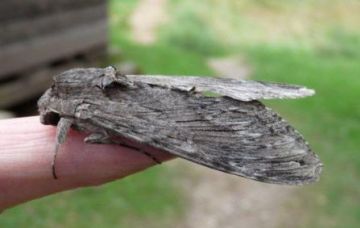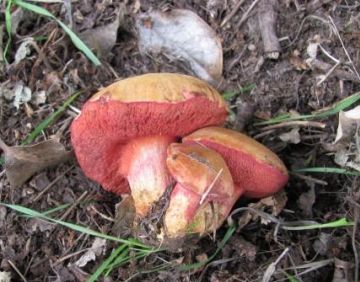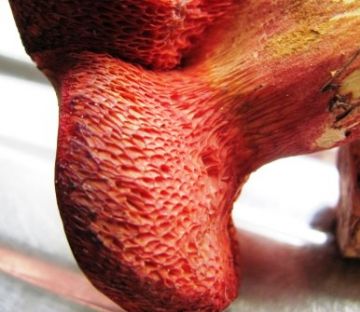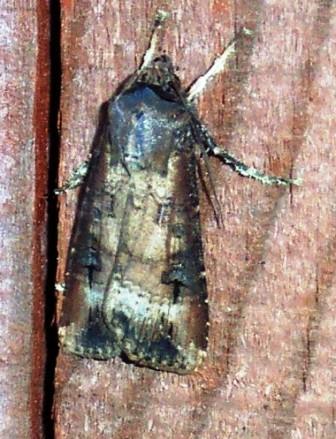Your Forum
The weblog below is for naturalists to use to report interesting sightings, ask questions, report on field meetings and generally post pictures and any information or questions generally relevant in some way to the wildlife and geology of Essex. You will need to register and be logged-on to post to the forum, and you need to upload pictures first, for use in posts. Find out more
|
Thu 23rd September 2010 19:34 by Graham Smith High Speed Moth
Sunday September 19th : A Friend, Dave Wagstaff, works as a manager at Burnham Co-op. On Saturday a staff member, who lives at Steeple, came out of her house to drive to work and found a large moth clinging to the side wall of one of her car tyres. Instead of removing it she left it there and proceeded to drive to Burnham, reaching 50-60 mph on occasion during the eight mile journey. Remarkably, when she arrived at the Co-op it was still there! Dave identified it as a female Convolvulus Hawk Moth (pictured), a long distance migrant from Southern Europe that can occasionally be seen in late autumn nectaring at fuchsia or tobacco plant blossom in gardens. Another friend, Bob Pease, a car designer (who took the picture) has set himself the task of working out the number of revolutions per minute the moth must have experienced during the twenty minute journey, assuming that the average speed was 35mph. A great manyI would surmise! Dave brought the moth to Bradwell Bird Obs on Sunday morning, where the photo was taken, and it was released unharmed - albeit with its head still in a spin - that evening.
Thu 23rd September 2010 16:45 by Graham Smith Field Club Fungi Foray to Swan Wood, Stock
Saturday September 18th : Eleven people gathered at the entrance to this Woodland Trust reserve at 11am and it is pleasing to report that there were a number of new faces among the regulars. There has been more rain so far this autumn than in each of the past three years and I was hopeful that this, the first Club foray of the autumn, would get things off to a good start. So it proved, although the interior of the wood was surprisingly dry : with the sap still rising until recently the trees had rapidly soaked up the early autumn rain. The wood itself was a little disappointing and appears to have deterioated in the past few years. For instance, the paths are very wide and far too numerous; dog walkers the culprits probably, but the result is an absence of any "quiet corners". Also, the Trust seems to lack the resources or the volunteers to carry out much coppicing work and the overgrown stools have shaded out much of the undergrowth, apart from along the central stream. These, of course, are problems common to many Essex woods.
Despite the dry conditions we identified 54 species of Basidiomycetes and I am sure Martin Gregory will come up with a few more additions from the smaller realms of fungi in which he specialises. Among the former were eight species of Russula, including R. acrifolia and R.pseudointegra, the English names for which are Crowded and Scarlet Brittlegill respectively; six Amanita, the Death Cap Amanita phalloides having pride of place among them; five Lactarius and four Xerocomus. One of our group was keen to discover which species were edible and Tony Boniface, the County recorder, suggested he taste the 'milk' of the aptly named Fiery Milkcap Lactarius polygallus. Definitely not on the menu, that one, as he discovered! Other species of interest included Panther Cap Amanita pantherina, Grey Coral Clavulina cinerea, Aniseed Funnel Clitocybe odora, the Lacquered Bracket Ganoderma lucidum (growing on Hornbeam) and several large clumps of the Giant Polypore Meripilus giganteus. The two rarest species were Dwarf Willow Shield Pluteus nanus and Chlorophyllum oliverieri, a parasol mushroom so scarce that it has yet to be given an English name. There are several records of the former on the BMI database for South Essex, most of them found recently by Andy Overall in the Greater London area, but none in either vice county for the latter. Fortunately, it was identified by Tony. All in all an excellent start to the season but we could certainly do with some more rain! Wed 22nd September 2010 17:04 by Ben Sale Webb's Wainscot
A lovely fresh example, captured from Sawbridgeworth Marsh last night using a net and torch, a first for me and from what i've gathered, not a common moth.
http://bensale-essexmoths.blogspot.com/2010/09/field-trip-sawbridgeworth-marsh-tuesday.html Thu 16th September 2010 20:14 by Graham Smith Silver-washed Fritillaries in Essex
With regards to Adrian Knowles article in the latest Club newsletter regarding the natural (?) re-colonisation of Essex by the Silver-washed Fritillary, I can add a couple more sightings to those he listed. On July 31st there were four holding territory along woodland rides in Stour Wood RSPB Reserve, Wrabness while another was seen briefly in the adjacent Copperas Wood EWT Reserve. Information on their presence there was passed to me by word of mouth so I presume this site is well-known. That doesn't necessarily mean that people send in their records though! At least a dozen White Admirals were also present, both species permitting wonderful views. At around the same time one was seen at The Backwarden EWT Reserve, Danbury and a few days later photographed in woodland just outside the reserve boundary. Hard to believe that all these records could relate to deliberate introductions but I have heard tales of Marbled White pupae being scattered around the County! Anyway, I will pass these records on to the new County Recorder. Mon 6th September 2010 20:27 by Graham Smith Rubinoboletus rubinus at Ingatestone
August 25th : Rubinoboletus rubinus, formerly Chalciporus rubinus (a species that is crying out for an English name!) is an extremely beautiful but scarce member of the Bolete, that is usually found growing under oaks. The small size, pale brown cap, cardamine pores (which are decurrent down the stem) and pale flesh, which turns pink in the cap and bright yellow at the base of the stem, generally serve to identify it. In his article on the Bolete of Essex in EN Vol.19 (2002) Tony Boniface lists records from (inevitably) Epping Forest and also Ian Rose's garden lawn at Mistley (!) while there have been at least four subsequent sightings from Hatfield Forest by Shirley Watson. There is also an earlier record, from Chigwell, in 1986, on the BMS Database. Thus this record appears to be the fifth recorded locality in Essex and is a welcome addition to the fungi of the Writtle Forest and surrounding area. I hope to include the photos in a display on the Bolete of the area at the Club's exhibition in December.
The fungi season is gradually gaining momentum in this area and if we can avoid any long spells of dry weather shows promise of being the best for years. A good recent find was Lactarius hysginus, found growing under Corsican Pine at The Hyde Lake, Ingatestone on August 27th. This is a fairly distinctive species - one of those with an extremely viscid cap - but I can find no Essex records either on the BMS Database or in Tony's article on Lactarius in the EN (Vol.24). Unfortunately, no specimens were kept (an oversight) although a full description was taken. It is described as 'seldom reported but apparently widespread' in the Checklist of British Basidiomycota. September 2nd was another good day, a sheltered hedgerow alongside College Wood, Fryerning yielding eight species of Bolete, namely, Boletus appendiculatus, B. reticulatus (over 40), B. edulis, B. luridiformis, B. radicans, Xerocomus subtomentosus, X. cisalpinus and Leccinum carpini - a fine haul and all within a few yards of each other. Thu 2nd September 2010 18:00 by Graham Smith Two Moth Nights
Blue House Farm EWT Reserve : August 21st : Despite the phones being down for three days previously, so that no one could book, thirteen people turned up on the night. Several were youngsters, whom on first sight I (being old and prejudiced) imagined would rather have been at the V Festival than looking at moths. My stereotyping proved unjustified as they really entered into the spirit of the thing and made the evening a great success, aided and abetted by the warden's two cats, which followed us everywhere and took an equally keen interest (albeit culinary rather than scientific) in our catch! There was a full moon but fortunately it was largely hidden by thick cloud and as it was a warm and humid night we caught a good range of species. Needless to say, the showiest example, a Poplar Hawk, was caught after they left; as indeed were two equally spectacular Great Silver Diving Beetles. Both traps were left set all night and the catch was as follows :
113 Flounced Rustic, 22 Setaceous Hebrew Character, 25 Rosy Minor, 24 Vine's Rustic, 18 Cloaked Minor, 11 Small Broad-bordered Yellow Underwing, 11 Rustic/Uncertain, 8 Common/Lesser Common Rustic, 7 Turnip Moth, 6 Straw Underwing, 6 Smoky Wainscot, 5 White Point, 5 Common Wainscot, 5 Orange Swift, 4 Yellow Shell, 4 Large Yellow Underwing, 4 Bright-line Brown Eye, 4 Shuttle-shaped Dart, 3 Flame Shoulder, 3 Chinese Character, 3 Brimstone, 2 Square Spot Rustic, 2 Dark Sword Grass, 2 Dark Arches, 2 Mouse, 2 Feathered Gothic, 1 Willow Beauty, 1 Scalloped Oak, 1 Poplar Hawk Moth, 1 Southern Wainscot, 1 Six-striped Rustic, 1 Common Wave, 1 Hedge Rustic, 1 Light Emerald, 1 Clouded Border, 1 Satin Wave. Total : 311 moths of 36 species. Dark Sword Grass - a regular migrant. Norsey Wood, Billericay : August 28th : Helped Les Steward and the Park Ranger, Chris Huggins, run a Bat & Moth Night at the visitor centre. Around 30 people attened the Bat Walk, of which a dozen or so remained for the moth trapping. In contrast to the 21st the night was cool and clear and catching was slow during the two and a half hours the traps were set. However, we caught a good selection of colourful species, Lesser Swallow Prominent, Green Carpet, Orange Swift, Yellow Shell, Brimstone, Light Emerald, Flame Shoulder and Marbled Beauty among them, which helped maintain interest. A less expected capture was a male Long-winged Conehead, a once rare cricket that is now widespread in Essex. Also of interest was a report from one of the people attending of 50 caterpillars of the Toadflax Brocade feeding on Purple Toadflax in a garden at Standford - le - Hope. There was a small influx of this rare moth into the County this spring but this is the first instance I have had of proof of breeding resulting from that. Previously, according to Brian Goodey (2004) suspected breeding had been confined to the extreme northeast of the County. It is possible, though, that this situation has changed in the interim. |
Archives: May 2020Aug 2019 Jan 2019 Sep 2018 Jul 2016 Oct 2015 Jul 2015 May 2015 Apr 2015 Mar 2015 Feb 2015 Jan 2015 Dec 2014 Oct 2014 Sep 2014 Aug 2014 Jul 2014 May 2014 Apr 2014 Mar 2014 Feb 2014 Jan 2014 Dec 2013 Nov 2013 Sep 2013 Aug 2013 Jul 2013 Jun 2013 May 2013 Apr 2013 Mar 2013 Feb 2013 Jan 2013 Dec 2012 Nov 2012 Oct 2012 Sep 2012 Aug 2012 Jul 2012 Jun 2012 May 2012 Apr 2012 Mar 2012 Feb 2012 Jan 2012 Dec 2011 Nov 2011 Oct 2011 Sep 2011 Aug 2011 Jul 2011 Jun 2011 May 2011 Apr 2011 Mar 2011 Feb 2011 Jan 2011 Dec 2010 Nov 2010 Oct 2010 Sep 2010 Aug 2010 Jul 2010 Jun 2010 May 2010 Apr 2010 Mar 2010 Feb 2010 Nov 2009 Oct 2009 Aug 2009 Jul 2009 Jun 2009 May 2009 Apr 2009 Mar 2009 Feb 2009 Jan 2009 Nov 2008 Oct 2008 Sep 2008 Aug 2008 Jul 2008 Jun 2008 May 2008 Apr 2008 Mar 2008 Feb 2008 Jan 2008 Dec 2007 Nov 2007 current posts |



























